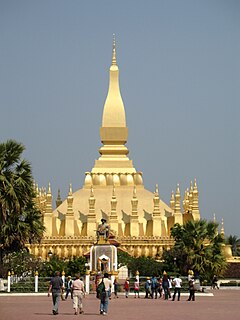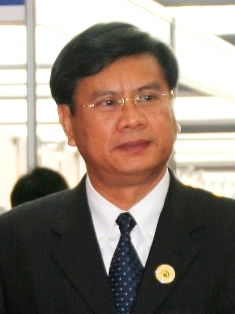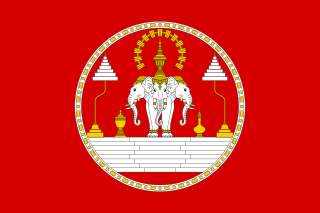Related Research Articles

Laos, officially the Lao People's Democratic Republic, is a socialist state and the only landlocked country in Southeast Asia. At the heart of the Indochinese Peninsula, Laos is bordered by Myanmar and China to the northwest, Vietnam to the east, Cambodia to the southeast and Thailand to the west and southwest.
The Lao people or Laotians are a Tai ethnic group native to Southeast Asia, who speak the eponymous language of the Kra–Dai languages, originating from present-day southern China. They are the majority ethnic group of Laos, making up 53.2% of the total population. The majority of Lao people adhere to Theravada Buddhism. They are closely related to other Tai peoples, especially with the Isan people, who are also speakers of Lao language, but native to neighboring Thailand.

The Lao People's Revolutionary Party is the founding and governing political party of the modern-day Laotian state. Its supremacy over the state is guaranteed by Article 3 of the national constitution. The party maintains a unitary state and has centralised control over the state and military.

The Lao Kingdom of Lan Xang Hom Khao existed as a unified kingdom from 1353 to 1707.
Major General Phoumi Nosavan was a military strongman who was prominent in the history of the Kingdom of Laos; at times, he dominated its political life to the point of being a virtual dictator. He was born in Savannakhet, the French Protectorate of Laos, on 27 January 1920. Originally a civil servant in the French colonial administration of Laos, during the last year of World War II he joined the resistance movement against the Japanese occupiers. Exiled from 1946 to early 1949 for his opposition to French return to colonizing Laos, he returned to his native soil to begin a military career in 1950 after the collapse of the anti-French Lao Issara government. By 1955, he was Chief of Staff of the brand-new Royal Lao Army. While in that position, he was largely responsible for appointing senior officers into command positions in the Military Regions of Laos. Following that, in 1957 he was the first Lao officer to be schooled in France at the École de Guerre. While in France, he became acquainted with Central Intelligence Agency operative John F. "Jack" Hasey. Phoumi returned to Laos to become a founding member of the Committee for the Defence of National Interests on 17 June 1958. On 25 December 1959, he took control of the capital of Vientiane and of the nation in a bloodless coup.

Theravada Buddhism is the largest religion in Laos, which is practiced by 66% of the population. Lao Buddhism is a unique version of Theravada Buddhism and is at the basis of ethnic Lao culture. Buddhism in Laos is often closely tied to animist beliefs and belief in ancestral spirits, particularly in rural areas.
Nang Keo Phimpha (1343–1438), an epithet meaning literally "The Cruel", was Queen of Lan Xang in 1438, taking the regnal name Samdach Brhat-Anya Sadu Chao Nying Kaeva Bhima Fa Mahadevi(Lao: ສົມເດັຈ ພຣະຍາ ສາທຸເຈົ້າຍິງ ແກ້ວພິມພາມະຫາເທວີ). She is also known by her title Maha Devi, and may have been the only reigning female sovereign of the kingdom of Lan Xang. According to some chronicles, she briefly occupied the throne for a few months, before she was deposed and killed at ninety-five years old. Her brief reign was the culmination of a ten-year period of regicide, which she orchestrated through a series of puppet kings.

The Prime Minister of the Lao People's Democratic Republic is the head of government of Laos. It is the highest office within the Government. The Prime Minister directs the executive branch of the state, and together with their government is accountable to the President, to the National Assembly and the Lao People's Revolutionary Party, the only legalised party in the country.

The French protectorate of Laos was a French protectorate in Southeast Asia of what is today Laos between 1893 and 1953—with a brief interregnum as a Japanese puppet state in 1945—which constituted part of French Indochina. It was established over the Siamese vassal, the Kingdom of Luang Phrabang, following the Franco-Siamese War in 1893. It was integrated into French Indochina and in the following years further Siamese vassals, the Principality of Phuan and Kingdom of Champasak, were annexed into it in 1899 and 1904, respectively.

The National Assembly is the unicameral parliament of Laos. The National Assembly meets in Vientiane.

Bouasone Bouphavanh was Prime Minister of Laos from 2006 to 2010. He was officially appointed to the office by the National Assembly of Laos on 8 June 2006, during a major government reshuffle. He replaced Bounnhang Vorachith who became vice president. Bouasone had previously served as first deputy prime minister since October 3, 2003. Before that, he was third deputy prime minister and was president of the State Planning Committee. He ranks seventh in the Politburo. He was replaced as Prime Minister on 23 December 2010 by Thongsing Thammavong. Now, Bouasone Bouphavanh currently serves as head of the Lao Party Central Committee's Commission for Economic Development Strategy Research.

The Royal Lao Government was the ruling authority in the Kingdom of Laos from 1947 until the communist seizure of power in December 1975 and the proclamation of the Lao People's Democratic Republic. The Franco-Lao Treaty of 1953 gave Laos full independence but the following years were marked by a rivalry between the neutralists under Prince Souvanna Phouma, the right wing under Prince Boun Oum of Champassak, and the left-wing, Lao Patriotic Front under Prince Souphanouvong and future Prime Minister Kaysone Phomvihane. During this period, a number of unsuccessful attempts were made to establish coalition governments.

The Constitution of Laos specifies the functions and powers of the government of the Lao People's Democratic Republic, and defines the rights and duties of Laotian citizens. The constitution was adopted on August 14, 1991, sixteen years after the 1975 establishment of the Republic, a period during which the country functioned without a written constitution or published penal and criminal codes. It consists of a Preamble and Articles, and legally establishes a set of authorities that resemble the traditional differentiation among executive, legislative, and judicial branches of government.
Trade unions in Laos have been active in the country since at least the mid-20th Century.

Laotian women have long been active participants in their nation's society, involved in politics, driving social transformation and development, becoming active in the world of business and serving as nurses and food producers for the military. Due to modernization and rural uprooting, Lao women have begun to embrace lifestyles that are foreign to traditional Laotian ideals.
Martin Stuart-Fox is a retired Australian professor and journalist who writes about the history of Southeast Asia, primarily Laos. In 1963 he was a contributor for the United Press International in Laos. In 1965 he moved to Vietnam and covered the war before leaving for France in 1966. After the war he gained more education and is now emeritus professor at the University of Queensland. He researches the religious symbolism and politics of Laos. On the subject of Laos he has written six books, fifty articles, and the Freedom House section on Laos for 2011.
The people of Laos have a rich literary tradition dating back at least six hundred years, with the oral and storytelling traditions of its peoples dating back much earlier. Lao literature refers to the written productions of Laotian peoples, its émigrés, and to Lao-language works. In Laos today there are over forty-seven recognized ethnic groups, with the Lao Loum comprising the majority group. Lao is officially recognized as the national language, but owing to the ethnic diversity of the country the literature of Laos can generally be grouped according to four ethnolinguistic families: Lao-Tai (Tai-Kadai); Mon-Khmer (Austroasiatic); Hmong-Mien (Miao-Yao), and Sino-Tibetan. As an inland crossroads of Southeast Asia the political history of Laos has been complicated by frequent warfare and colonial conquests by European and regional rivals. As a result, Laos today has cultural influence from France, Thailand, China, Vietnam, Burma, and Cambodia.
Voravongsa I was king of Lan Xang reigning from 1575–1579 with the regnal name Samdach Brhat-Anya Chao Brhatasena Vora Varman Raja Sri Sadhana Kanayudha but he is commonly referred to in both Lao and Burmese chronicles by his title of Maha Oupahat or Viceroy. Voravongsa was taken prisoner by the Burmese in 1565 during the occupation of Vientiane. In 1575 following the third of a series of Burmese invasions of Lan Xang, Voravongsa was appointed by Bayinnaung as a vassal within the Taungoo Empire. Voravongsa had few supporters even within the Burmese court; he reigned for only four years before facing a popular rebellion which would threaten to overtake the capital in Vientiane. Voravongsa attempted to flee back to Burma, but were killed en route. To reestablish order the Burmese dispatched another army, and would install Sen Soulintha as vassal from 1580-1582.
The Ministry of Justice of Laos existed as far back as the Royal Lao Government (1940s). It was not until the first Laos government in 1975 that the ministry took a more active role in the creation and operation of the judiciary, court system, and the rights and freedoms of Laotian citizens. Additionally, the Prime Minister might guide the Ministry of Justice's role in regards to the legislative branch, the dissemination of law, and the promotion of legal education.
References
Specific
- ↑ Stuart-Fox 2008, p. 67–8.
- 1 2 3 4 Stuart-Fox 2008, p. 68.
Bibliography
Books:
- Stuart-Fox, Martin (2008). Historical Dictionary of Laos. Scarecrow Press. ISBN 978-0-81086-411-5.
| | This Laos-related article is a stub. You can help Wikipedia by expanding it. |